This post and the photos within it may contain affiliate links. If you purchase something through the link, I may receive a commission at no extra charge to you.
Calligraphy books are one of the best resources for learning calligraphy as a beginner.
In this article, I review 10 of the best calligraphy books for beginners.
These calligraphy books are part of my collection that I have been gathering for the past couple of years.
The art of calligraphy encompasses a wide variety of styles and techniques, and this list contains books to satisfy any calligraphy style you’re set to study and practice.
Here is a quick overview of this article –
- 10 Best calligraphy books
- Bonus books (hint – free calligraphy PDF online books!)
- Final words
So let’s get started!
Note – If you’re just getting started with calligraphy, I highly recommend you check out my ultimate guide for calligraphy beginners.
1. The Calligrapher’s Bible by David Haris

Number one on my list is a very popular book loved by many calligraphers worldwide.
The Calligraphers Bible is a collection of 100 complete alphabets and a basic introduction for calligraphy beginners.
David Haris really didn’t hold back and included such a fantastic variety of calligraphy styles for you to study and practice.
You’ll find traditional calligraphy styles such as Roman Capitals, Uncials, Carolingian, Textualis Quadrata (blackletter), Fraktur, Chancery (Italic), all the way to various modern calligraphy scripts.
I really like the Calligraphers Bible because the scripts are laid out and categorized based on major historical eras such as – Roman, Insular, Gothic, Renaissance, Baroque, and Modern.

Each alphabet is laid out on two pages.
On one side, you’ll find the entire alphabet of a specific script (hand) along with a ductus.
On the other side, there are practical tips and various points of interest that will help you with your calligraphy practice.

The Calligraphers Bible, although it is a fantastic book, it doesn’t really cover these calligraphy scripts in much detail.
Therefore I consider it more of a reference book than a book that will provide you with in-depth knowledge about calligraphy scripts.
If it did, it would probably be a giant book!
This is a small practical (and portable) book that you can use as a point of reference when practicing a calligraphy script.
The spiral-bound is also a significant detail worth mentioning.

All in all, the Calligraphers Bible is a great book that will keep you busy for years!
2. Foundations Of Calligraphy by Sheila Waters

Next up, we have a true calligraphy book gem.
I love all the books on this list, but Foundations Of Calligraphy is a very special book for me personally.
It’s the one book that really opened my eyes to the nuances of the art of calligraphy.
Sheila Waters was an exceptional calligrapher, and she has compiled decades of studying and experience into this beautiful book.
Filled with both instructional and inspirational material, this book will take you through a learning experience that no other book can (at least in my opinion).

Foundations Of Calligraphy is mainly focused on traditional broad-edged calligraphy scripts.
The whole book is structured to guide you from the most basic Roman Capital letter constructions to minuscules (foundational hand) and all the other scripts that have subsequently evolved throughout history.
Btw. If you’re interested in learning more about calligraphy styles, be sure to check out my article on the 10 calligraphy styles.

For example, it covers major scripts of different eras and not so many specific variations as the Calligraphy Bible does.
The book contains instructions on setting up your writing environment, writing, sitting, holding the pen, and more.

It also teaches you how to effectively practice and prepare for professional calligraphy projects, layouts, composition, and design concepts such as balance, rhythm, symmetry, etc.
I mean, the list goes on and on.
What makes this book so special is the myriad of nuanced tips that Sheila sprinkled all over the book.

These are those deeply craved “aha” moments that only someone who spent their life studying the craft can know.
I HIGHLY recommend this book for ANYONE interested in learning and getting a deeper understanding of the art of calligraphy.
3. Mastering Copperplate Calligraphy by Eleanor Winters

If you prefer more pointed nib calligraphy and the copperplate style, this book is an excellent choice.
Eleanor Winters made a complete breakdown of the copperplate script in this book.

Here are just a few of the things you will learn from Mastering Copperplate Calligraphy –
- Historical overview
- Terminology and setting up guidelines
- A complete breakdown of capitals, minuscules, numbers, and punctuation
- Layouts and compositions
- Working on commercial projects
- And much more.

Mastering Copperplate Calligraphy is well suited for both beginners and more experienced calligraphers.
I’ve also found ideas and principles that were helpful for my hand lettering skills (drawing letters).
I particularly liked this book’s extremely detailed section about how to write both minuscules and capitals.
There aren’t just examples of how to write the letters but also examples of poorly executed letterforms that you can use as a very useful reference point.
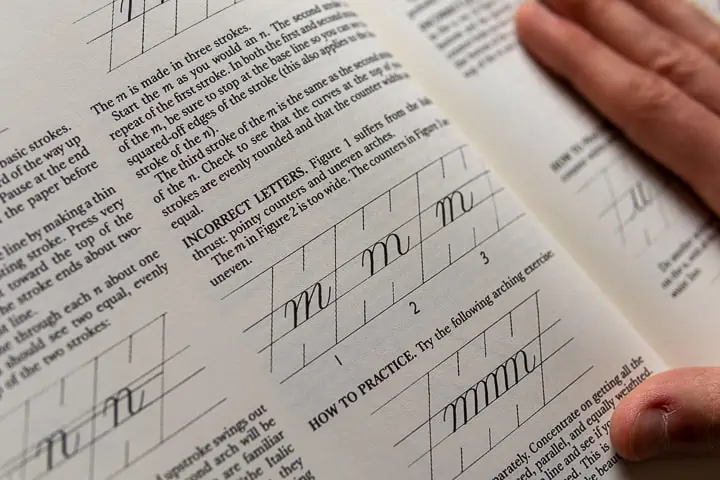
It also goes super deep into letter connections and letter-spacing (among other things), leaving almost nothing to doubt.
If you want to get started right away, you can check out this copperplate calligraphy tutorial for beginners.
Quick Bonus book – Copperplate Script: A Yin and Yang Approach
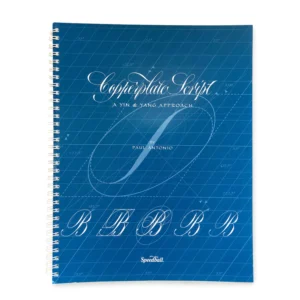
If we’re talking about copperplate calligraphy books, I must mention Paul Antonio’s book. I haven’t personally read the Yin and Yang Approach, but I have heard sooo many good things about it. Paul is also a friend of mine, and I know that this book is jam-packed with knowledge and experience accumulated over decades of intensive studying, practice, and love for the art of calligraphy.
4. The Art Of Calligraphy – A practical guide to the skills and techniques by David Harris

If someone asked me what the best book to start learning traditional calligraphy scripts is, I would recommend The Art Of Calligraphy By David Harris.
And yes, it’s the same David Harris that created the Calligraphers Bible that I mentioned earlier.
This book is so well made from the content structure, historical overview, and clear presentation of the many alphabets to just the general design of each page.
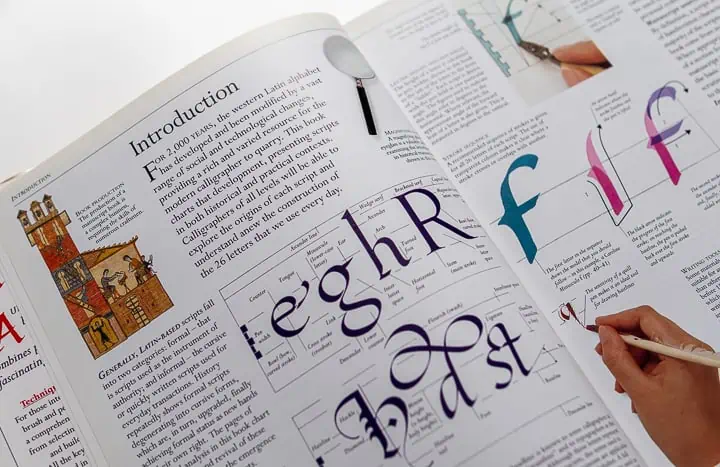
The Art of Calligraphy gives you everything you need to start learning and practicing a variety of calligraphy styles.
I really like this book because it teaches you some of the most popular calligraphy scripts in the history of the Latin alphabet.
And it does that chronologically as they developed throughout more than 2000 years of history.
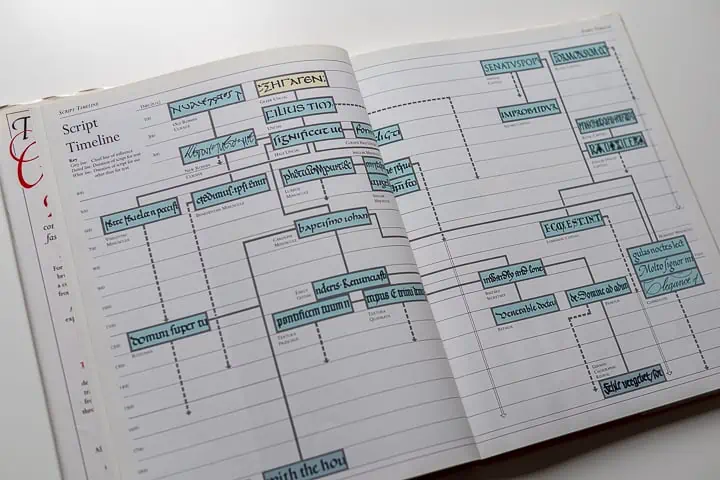
Additionally, I love how each script (style) gets such a detailed presentation laid out on both pages of the book.
You really get a clear view of the ductus of each letter that is even built up in different colors.

Perhaps the book’s only drawback is that it doesn’t have a spiral-bound.
However, that’s just my personal preference.
Nonetheless, this is a fantastic instructional book that will help you get started with the art of calligraphy.
5. Modern Calligraphy by Molly Suber Thorpe

Are you interested in learning modern calligraphy with a pointed nib?
Well, if so, look no further!
Because Molly’s book has you covered.
This book is very nicely designed, and it’s packed with a ton of great information.

It will teach you all the basics needed to create fun and whimsical letterforms in no time.
Molly will guide you through the basic supplies, practice strokes, and a wide variety of styles for both capital and minuscule letters.
You’ll also learn about layouts, spacing, compositions, advanced tools, and a section dedicated to left-handed calligraphers.

But wait, that’s not all.
The cherry on top is that the second half of the book is a collection of D.I.Y. project ideas.
Projects such as custom envelopes, postcards, stamps, and more.
Molly made sure to give you enough ideas to put all the practice into work.

Be sure to check my tutorial on how to get started with modern calligraphy using a brush pen.
There is also a similar tutorial, but this one focuses on how to do modern calligraphy with a dip pen.
6. Calligraphy – A complete guide by Julien Chazal

I would describe this book as an advanced version of the Art Of Calligraphy by David Harris.
It offers an in-depth look at various calligraphy styles – from traditional to modern scripts.
Each script has been clearly laid out on the page with a comprehensive ductus (little arrows indicating the direction of strokes).
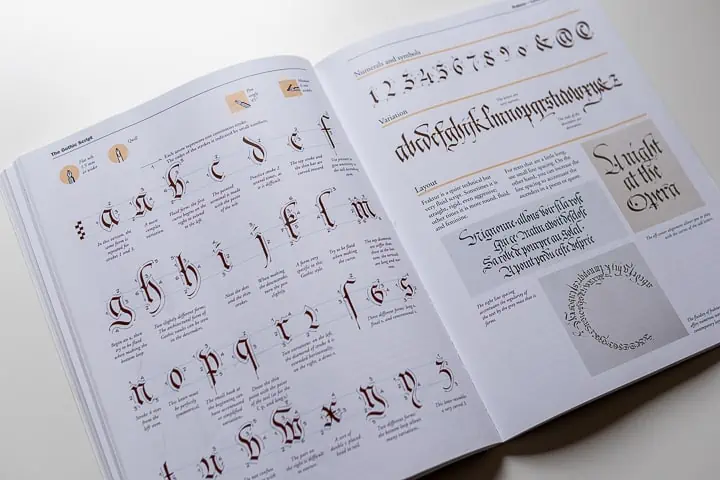
I really like that each letter of every alphabet in this book contains a little note underneath, giving you extra insight into how to correctly write it.

Julien also covers the basics of calligraphy.
From tools, terminology, basic strokes, letter structures, and more.
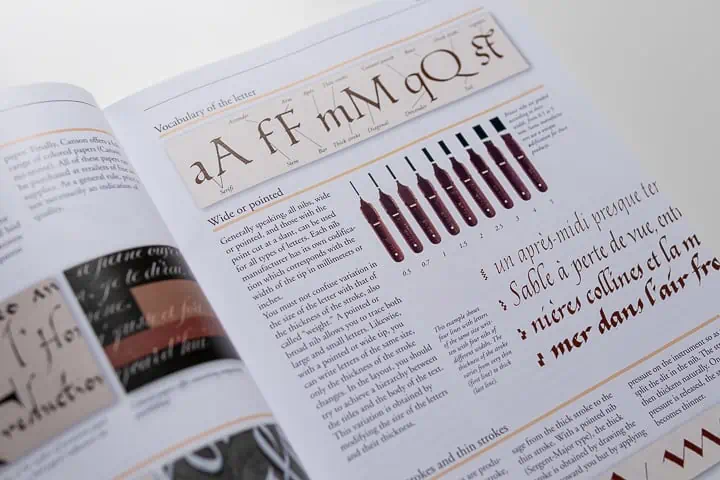
To wrap up this remarkable book, there is a whole section on decorations and layouts that will further enhance your calligraphy skills.

If you’re just getting started with calligraphy, I would instead recommend the Art Of Calligraphy by David Harris.
However, if you’ve been practicing calligraphy for a while now, you’ll benefit from all the extra in-depth knowledge Julien shares in this fantastic book.
7. The Speedball Textbook (multiple editions) by a variety of artists

The Speedball Textbook series has recently celebrated its 105th anniversary.
Yup! 105 years!
The Speedball Textbook was initially created by Ross F. George as an instructional manual.
Last year the latest (25th) edition was released, and it has become so much more than that.
First of all, let me say that the 25th edition is just out of this world.
Not just because it contains a ton of great reference alphabets and jaw draping calligraphy artwork for inspiration.

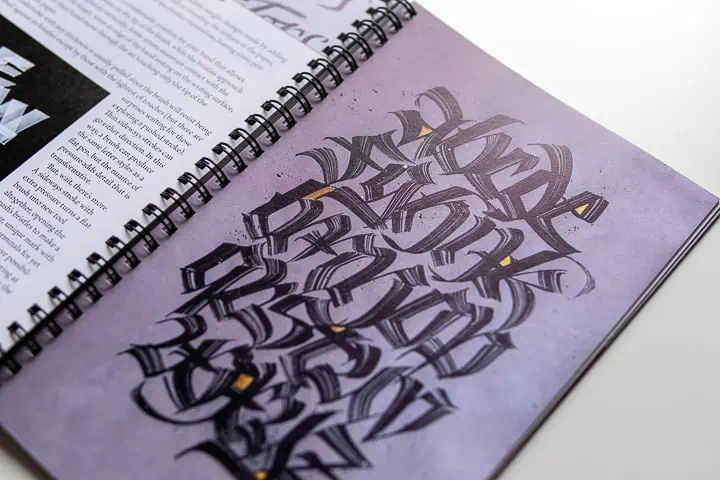

Seeing dozens of skillful calligraphers from all over the world coming together and creating this absolutely fantastic booklet is fantastic.

I currently have the 23rd and the 25th edition.
I would love to eventually increase my collection and have all of them.
If you are interested in getting a Speedball Textbook, I would definitely recommend going with the 25th edition.
It is filled, and I mean jam-packed, with many different styles and reference alphabets for you to practice from.
You won’t just find calligraphy inspiration. There is also content on hand lettering, sign painting, improving handwriting, and more.



From traditional scripts to modern interpretations, I really believe that the 25th edition of the Speedball Textbook offers something for everyone.
8. Medieval Calligraphy – Its History and Technique by Marc Drogin

If you like to read about calligraphy history (as much as I do), you’ll love this book.
When I started researching the history of the Latin alphabet and its development throughout the years, I’ve come across many contradictions and a general lack of information.
Unfortunately, there is a ton of information online, and there is a variety of interpretations when it comes to exact dates and correct nomenclature.
Marc’s book is a fantastic read with many references, and you can really tell that it has been very well researched.


The book is divided into two main sections.
The first is the detailed historical overview, and the second is more of a “how-to” packed with historical references.

I really love the first part of the book, where Marc describes the development of the Latin alphabet in great detail.
All the way from its early development and the Roman Capitals to the peak of the gothic scripts.
Each page is filled with detailed text and many reference images from various manuscripts.
I particularly enjoyed reading about the way scribes used to live in that day and age and the funny story about Titivillus A.K.A. The Patron Demon Of Calligraphy 😀


The only thing I wish was presented in more detail was the instructional part of the book.
Don’t get me wrong, it contains great info and insights. I just wish it was presented better and more comprehensively, like, i.e., The Art Of Calligraphy.
9. Writing & Illuminating & Lettering by Edward Johnston

Would you believe it if I told you that this book was originally published in 1906?
This book and its contents have been around for over 100 years.
In case you haven’t heard of Edward Johnston, he is considered to be (among others) the father of modern calligraphy.
He is famous for his design of the Johnston’s typeface and the London Underground system and his vast influence on a generation of calligraphers and type designers.
His book, Writing & Illuminating & Lettering, is a must-have for any calligrapher/lettering artist.

In Johnston’s book, you will find a ton of crucial information that will give you a much deeper knowledge about calligraphy.
The book is divided into two parts.
The first part focuses on writing and illuminating.
Things such as setting up your writing environment, choosing the correct tools, how to hold the pen, spacing, creating (and planning) manuscripts, versals, gilding, and more.

The second part is oriented toward more theoretical teaching of lettering and calligraphy.
The qualities of good lettering, constructions, arrangement, proportions, layouts, compositions, and more.

I really enjoy the rich content of the book’s second part, and I often come back to it.
The way I read this book was like any other book. In the morning, with a cup of coffee, while traveling somewhere, etc.
It is not like other books on this list, one which you would use as an exemplar for you to copy from.
It’s a smaller-sized book which makes it convenient for traveling and similar situations.
10. The Bible of Illuminated Letters by Margaret Morgan

This book stands out from this list since it has a specific focus on the world of calligraphy.
As the title says, this book focuses on teaching you how to create illuminated letters.
We’ve already written a beginner’s step-by-step tutorial on how to create illuminated letters.
However, this will give you a much broader perspective on the subject.
The Bible of Illuminated Letters will take you on an in-depth journey on how to create illuminated alphabets throughout six major historical periods.
These periods are –
- Celtic
- Ottonian
- Romanesque
- Gothic
- Renaissance White Vine
- Renaissance Neo-Classical

Aside from the in-depth information about these styles, you’ll learn other valuable skills such as –
- Setting up a workstation
- Paper, vellum, and parchment
- Brushes, pens, pencils, paints, and inks
- Gilding
- Layout and design
- and much more

Honestly, I think that this is one of the best resources for learning how to create illuminated letters.
Bonus Calligraphy book #1 – Collection (Sammlung) Hermann Zapf

This book is very special to me.
It’s not an instructional book but rather a great source of inspiration.
If you haven’t heard of Hermann Zapf, you can read more about him and his work here.
However, in short, he was one of the greatest calligraphers and type designers of the 20th century.
And also a huge personal inspiration for me.

This book is a collection of some of the best works created by Hermann Zapf.
Honestly, when I go through these pages, I have a hard time conceptualizing how absurdly magnificent his work is.

It is slightly more expensive than the other books on this list, but it is totally worth it.
Jam-packed with a ton of inspiration, a very high-quality print, and just an excellent book for your collection.

Here you can see some of my favorite pages from this book.
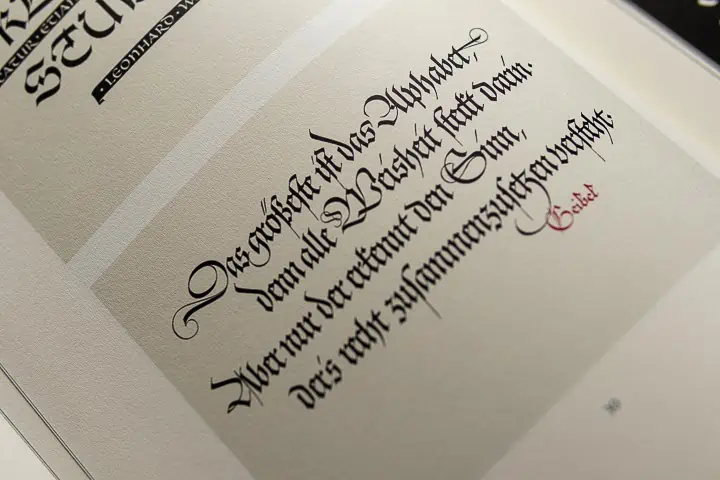

Bonus #2 Free online calligraphy books
I love free stuff!
I mean, who doesn’t?
Over the years, I’ve stumbled upon a couple of free books online, and I figured it’s worth sharing them with all of you.
Here are the links to several free online calligraphy books –
- La Operina by Ludovico Arrighi (1522) is a great source of inspiration for the chancery (italic) script – https://archive.org/details/laoperinadiludou00arri/page/n19/mode/2up?view=theater
- Flowers from nature and ornamental flowers: studies of flowers and foliage with various interpretations applicable to illumination and decoration (1890) – https://archive.org/details/fleursdaprsnatur00guil/page/n75/mode/2up
- The Zanerian Manual (early 1900) is a collection of beautiful American penmanship – https://masgrimes.com/archive/zanerian-manual
- The Penman’s Handbook (1883). Contains both instructional elements as well as a ton of inspiration – https://archive.org/details/penmanshandbookf00gask/page/166/mode/2up
- The IAMPETH rare books library – You will find over 50 online jaw-dropping calligraphy books here. This is an insane resource – https://www.iampeth.com/rare-books
Wrapping it up – final words about the best calligraphy books.
There you have it, friends.
These are some of my favorite calligraphy books that I have found so far.
Calligraphy books are a great source of knowledge and inspiration.
I’ve learned so much throughout the years with the help of these books, and im sure you will too.
It is possible that, with time, I will change and update this list.
In the meantime, let me ask you something –
What is your favorite calligraphy book?
Do you think I should have included some other books in this list?
Feel free to drop a comment below.
Until the next time,
Stay AWESOME!
Pin me!

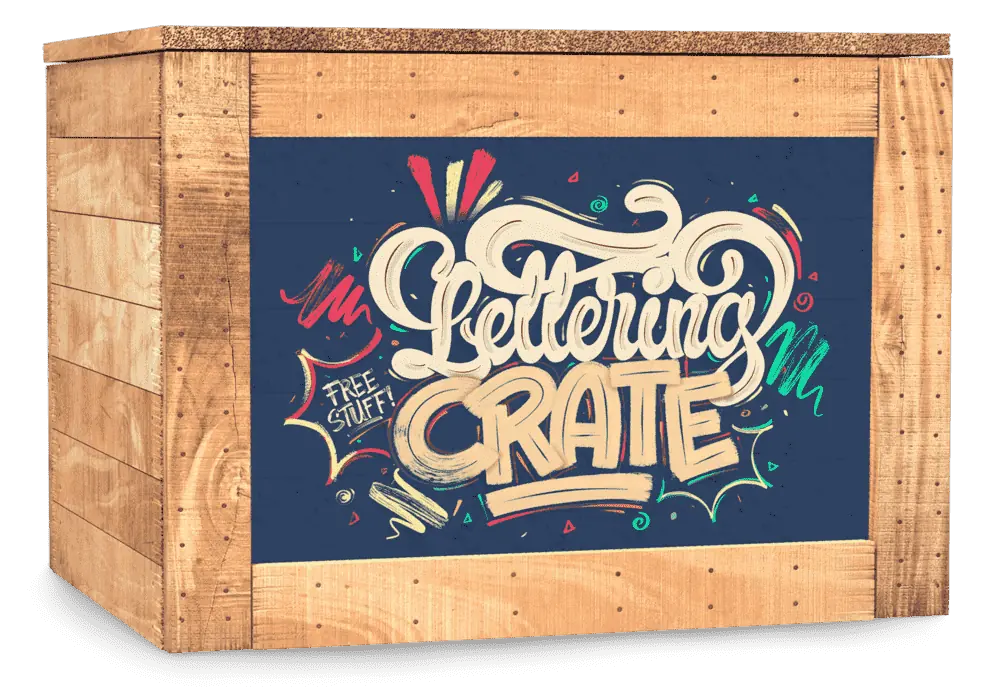
Stay updated with my tutorials and get instant access to the Lettering Crate –
A growing library of free lettering & calligraphy resources that includes –
About the author

Hey, I’m Max Juric, and I’m deeply passionate about calligraphy and hand lettering.
I’ve spent years honing my skills in the art of lettering, working with hundreds of clients from all over the world on design projects such as logotypes, branding, custom lettering, murals, and more.
But my journey doesn’t end there. I’ve also dedicated myself to sharing my knowledge and expertise with others, creating a wealth of resources including tutorials, articles, and podcasts.
It’s been incredibly rewarding to see thousands of people engaging with my content each month. Knowing that I’m helping fellow enthusiasts grow and develop their skills makes me really happy.
Welcome to Lettering Daily, your hub for all things lettering and calligraphy. Whether you’re a seasoned pro or just starting out, I’m here to inspire and guide you on your lettering journey. Stick around, and let’s explore the world of letters together!


Hiya, I am enquiring for a friend of mine… he is looking for a calligraphy book that talks about these things… and he is amazing and I wanted to get him a book for Christmas:
Here is what he is looking for, he is an artist and art teacher….Someday I hope to find a calligraphy book that includes a chapter on practical tool care. Of course most writers focus on letter form, alphabet history, composition on paper, all the academic stuff.
But I want a chapter on keeping the nibs clean. How to make quills. I once saw a historical documentary style show, and the scribe stored his quill by jabbing the point of it into an apple on the table! So I’m going to try that. Maybe the malic acid in the fruit will help keep ink from hardening on the nibs.
Anyway, I’ve been working on refreshing my tools, so they’ll be ready and prepared for more inspirational phrase
If you could help at all I would be most grateful,
Sincerely,
Heide
Hi Max , I’m just a beginner . Planning to buy some simple basic calligraphy books And went through your recommendations about the best books . I think I should start with Art of calligraphy by David Harris , is that a right decision……????Please help.
And yes Evelyn is 100% correct foundation of calligraphy by Shiela waters is way too expensive in Australia . On Amazon AU its $339 . Don’t know if it’s a correct price or not !
Regards
Naiya
Learning calligraphy can be a difficult and time-consuming task. Writing in an elegant, consistent style requires patience and practice. Developing the coordination of your hand with the pen or brush takes time.
Anyways, read the below. This might help.
https://www.reblogit.com/the-calligraphy-journey-a-beginners-guide-to-learning-and-mastering-the-art-form/
—
Regards,
Reblog it
Do you have recommendations for practice workbooks. I have been trying to find practice workbooks but can only find totally empty ones and I want ones to help me form the strokes better.
Hi, I am new to calligraphy and am looking for practice books. Are there any good ones that have lots of practice space and also traceable letters to help newbies? I want to make sure that I am forming the strokes right.
I enjoyed your list, but my question is what would be a good workbook that lets you trace the letters while you are learning? The book I have has no practice space and all the workbooks I find are blank. I need something to practice on so I can make sure I am forming the letters correctly.
Can you recommend anything for that? I don’t want to download and print on regular paper as I had read that calligraphy paper is not the same and it won’t work right or can mess up the pens.
Thanks so much!
There are a ton of free worksheets you can download from the Lettering Crate. You just get nicer calligraphy paper and print the worksheets on that – this way you wont damage your pens. There are some traceable books but they are often complete garbage. Incorrect proportions, sizing, crappy paper quality, etc. Doing it yourself is much easier and also cheaper.
This blog is so useful. Extremely well curated list. Kudos to the hardwork that went into the research.
Thank you Aniiii! 😀 I really appreciate your constant support 🙂
Wow, what a wonderful article, I am so looking forward to the books I ordered based on your recommendations, thank you! here’s to lovely penmanship!
Nice! Which books did you end up getting?
Many thanks for sharing this list and your impressions.
I’m a neophyte here. I discovered that I already have a book called ‘The Encyclopedia of Calligraphy Techniques’ by Diana Hardy Wilson ISBN 0-7472-0160-9 which I must have bought years ago and completely forgotten about. Anyway, it has aroused my interest. So, here I am wanting to learn how to actually do it. Consequently, I began looking for books that are suitable for beginners who want to learn. That’s how I found your Web page.
‘Foundations Of Calligraphy’ by Sheila Waters sounds interesting, but I have been unable to find a copy at a reasonable price, likewise ‘The Art of Calligraphy’ by David Harris. So, I bought a copy the ‘Calligrapher’s Bible’ by David Harris instead. Then I discovered ‘Learn Calligraphy’ by Margaret Shepherd ISBN 978-0-7679-732-3 which is exactly what I was looking for. It is excellent.
Meanwhile, I am puzzled about why Celtic insular script does not appear in the the ‘Calligrapher’s Bible’ – the word Celtic does not appear anywhere, whereas Margaret Shepherd’s book has about a dozen pages devoted to Celtic script and Celtic script is certainly discussed clearly in the ‘Encyclopedia of Calligraphy Techniques’.
Whilst searching for a copy of ‘The Art of Calligraphy’ to buy, I have discovered it can be downloaded free-of-charge from at least two websites in PDF format! How good is that? I don’t have an ebook reader that displays colour, but I do have a tablet. ( ͡ᵔ ͜ʖ ͡ᵔ )
Celtic doesn’t appear in the index of the PDF version, nor can I find it in the text. Whereas, according to Diana Hardy Wilson, “The Uncial and Half-Uncial are acknowledged as the inspiration for the Celtic insular script used to produce the famous Book of Kells”.
So my question is, why has David Harris apparently ignored Celtic script in his two books? I would be grateful if you could enlighten me.
Hey Ron, thank you so much for the excellent comment and thoughtful question. I’ll try my best to answer this. The thing about the history of the Latin alphabet is that there is a lot of confusion. In the years I’ve been learning, studying, and practicing calligraphy, I’ve spent many hours doing historical research. Mostly from what I can find in books and online since that’s the only thing available to me. Of course, it would be foolish not to acknowledge my friendship with Paul (PA Scribe) and his vast knowledge of the topic, mainly because he devoted his life to the craft and studied paleography at a university. Throughout the years, he has shed light on a bunch of my questions which was helpful but, at the same time, causing even more confusion because there is so much contradictory information. I’ve found resources and books that use different dates and terminology. For the most part, to determine a general timeline of how the scripts developed and evolved, everything is fine. The problem begins when it’s time to select small details such as precise locations, dates, and terms. I have the books you mentioned, and I double-checked, and you’re right.
D.Harris hasn’t said “Celtic” scripts, but that’s because he refers to them as Insular (majuscules and minuscules). Other books do the same. Drogin’s book on Medieval Calligraphy talks about the same thing as Shepard did in her book. St. Patrick came to Ireland around 500 AD, bringing the Uncial, blah blah blah. However, Drogin also uses the term Insular rather than Celtic. He mentions Celtic art but not as a writing script. I know it’s frustrating, and I would also love to get a concrete answer defining the whole story. Unfortunately, history is complicated, and I’m afraid I can’t give you a straight answer as to why some people use specific terms.
Nonetheless, the scripts are represented in the book. They just use a different name. If you want to learn more, I suggest getting Drogin’s book. It’s super exciting, and I love it (that’s why it’s on my list). Alternatively, you can also reach out to Paul. He is a walking encyclopedia of knowledge on this topic, and I’m sure he wouldn’t mind giving you a much better explanation. I hope this helps; let me know if you have any other questions 🙂
Thank you for all the wonderful information. I am older but a total beginner & would like to have something for an absolute beginner. The books you suggested are beautiful but very much above my level. I basically want to choose a favorite script that I can perfect to use regularly. I hope this isn’t too basic for you to address 🙂
Hey Linda, these books are created for beginners. The work you see inside of them may seem very advanced, but i assure you that it contains all the needed info. for you to get started. If you have any questions, please let me know 🙂
Hello to all the community. Very happy to know you, and to can discuss, find answers. I’m french, sorry for my bad english^^
I’m a beginner and interested in calligraphy pens/markers. Like Parallel Pens, or chisel nib markers… I have a specific question about the shape and dimensions of the nibs:
There are different widths, for example 6 for PPP (1.5, 2.4, 3.0, 3.8, 4.5, 6.0 mm). But you can never choose or vary the thickness of the nib. They therefore always have more or less the same thickness. They are always very fine.
So I’m wondering if there are any tools, or pens, or nibs, or tips,… that would provide greater thickness? For slightly less different upstrokes and downstrokes.
Thx a lot.
If you’re looking for something like that then you could go for a felt-tip broad-edged marker. They are slightly thicker than the PPP.
This is really nice list, as a beginner, I found both of David Harris’ books great resources. I also have the bible of illuminated letters, but that is definitely something to aspire to. thank you.
Thank you for the kind comment! 🙂
This is a very interesting list. I have five of the ten, but there needs to be more of the “beginner” books that are available that go more into the basics. Several topics that I consider truly basic involve, supplies, how to hold the pen, how to dip the pen, various options including Parallel Pens, how to practice and good, clean samples of well done calligraphy. I used to have an extensive collection, but gave most of it to my local library. From what I kept I suggest these three: The Craft of Calligraphy by Dorothy Mahoney; Learn Calligraphy by Margaret Shepherd; and The Complete Calligrapher by Frederick Wong. This is pretty much the order in which I would recommend them, but the one I most often go back to read is the Wong book. Of course, I love the Waters book (but fairly expensive!) and I have and use the two “Bibles” for frequent reference. Other Shepherd books are nice “optionals,” each one touching on specific topics, like her one on Borders.
You have nice choices here, and I think, of course, that with practice and dedication anyone can become a competent calligrapher with only the “textbooks” from Speedball. The first Speedball I bought was the 19th Edition (in1965) and I wish I had kept it! I also bought the 20th edition (also gone, alas) and I bought the latest two (24th and 25th editions), making these four the only ones I ever bought two editions in a row.
Keep up your good work — even old timers (like me? I’m now 83!) want to see what you have to say.
Thank you, Gary! There are a ton of beginners book out there. I wanted to have a more concise list with several choices, but I might expand the list in the future. My goal was also to diversify the selection and offer a bit of something for everybody. I have Shepherd’s book and although I do like it, I just like these books more. I guess it’s a matter of personal preference. I’ll check out these other books that you have recommended. Also, if you know a place online where I could grab some older versions of the Speedball textbooks, please let me know. I currently have only 2 editions and I would love to eventually have them all. Thanks again, Gary. I really appreciate your support! 🙂
Max, this is an excellent list and your comments about each book are very helpful. I have four of the books you listed and I’ll be looking into getting copies of #8 and #9 today. Thanks again!
Hey Drew! That’s awesome! Im so glad you liked the list, and I’m sure you’ll love these books as much as I do 🙂
Hi
Thanks – this is great! I have both the calligraphers bible and the illuminated letters book. They are really good. I’m in module 2 of a calligraphy course currently working on foundational letters.
That’s awesome. I love the Calligrapher’s Bible. Such a great reference for practice and various projects. I particularly like the modern section of various scripts 🙂
You have certainly chosen some really great books – I have a number of them in my own library.
I totally agree that Foundations of Calligraphy by Sheila Waters is one of the best Calligraphy books available. I was fortunate to be able to take a week long calligraphy course with her – and it was amazing! Her knowledge is just incredible.
I hope you don’t mind a suggestion for your readers – your link to buy the book goes to Amazon where it is listed for $94.52US for used copies (and in Canada for $236.40!). Sheila said she could never understand why Amazon listed it that high. She suggested that we go to John Neal Books where you can get it for $35.00US – https://www.johnnealbooks.com/product/foundations-of-calligraphy. That’s where I got my copy and it is one of my treasures!
Hey Evelyn, thank you so much for the correction. I will add a link to that as well. I just need to find a European supplier as well. I honestly cannot remember where i got mine from 😀 Nonetheless such an amazing book. I envy you for your course with Sheila, I bet it was an insightful experience 🙂
Good read, Max! Great insights into each book, and great resources, including the freebies!
You asked what books you listed are on my shelf: I was given Harris’ Calligrapher’s Bible for Christmas 2021, and have enjoyed using Lloyd J. Reynolds’ book, Italic Calligraphy & Handwriting, since my dad gifted it to me in 1987. Both have been a blessing to refer to, along with other miscellaneous resources.
In addition, I have a copy of The Hunt Brothers’ Lettering of Today, fifth printing 1944, which is mostly a showcase of lettering styles for inspiration. And finally, I have copies of a few older lettering booklets. My favorite one, from Hunt Manufacturing Co, 1960, is cram-packed with fun and informative inspiration.
Thank you for all the good info you share!
Hey Julie, thank you so much for the great suggestions 🙂 I’ll check those out for sure. Lloyd Reynolds is fantastic, I’m familiar with his work. I also found some older instructional videos of him on Youtube – https://www.youtube.com/watch?v=v22dewR4izg&list=PLy6-FkXJFXKwoLdEF0eATKJ80vE3IICGY
Just beginning my lettering journey, and WOW! you have shared quite a lovely and helpful resource here. Thank you for taking the time to put this together for all of us.. it’s great to get a pro’s insight on favorite educational and reference material. Loved the archive bonuses!!
Thank you, Kaye! Im really glad you liked the article 🙂 Do you have a calligraphy book that you particularly liked?
Interesting list. I just took an online class from Cheryl Tefft yesterday and she was saying how she mainly learned calligraphy from books when she was starting out as that was all that was available to her. Even with all the online resources available now, there is still lots to be gleaned from reading.
Thank you for the comment, Margaret. Books are awesome, and I’ve honestly learned A LOT from reading them. Hope that it will help others as well 🙂